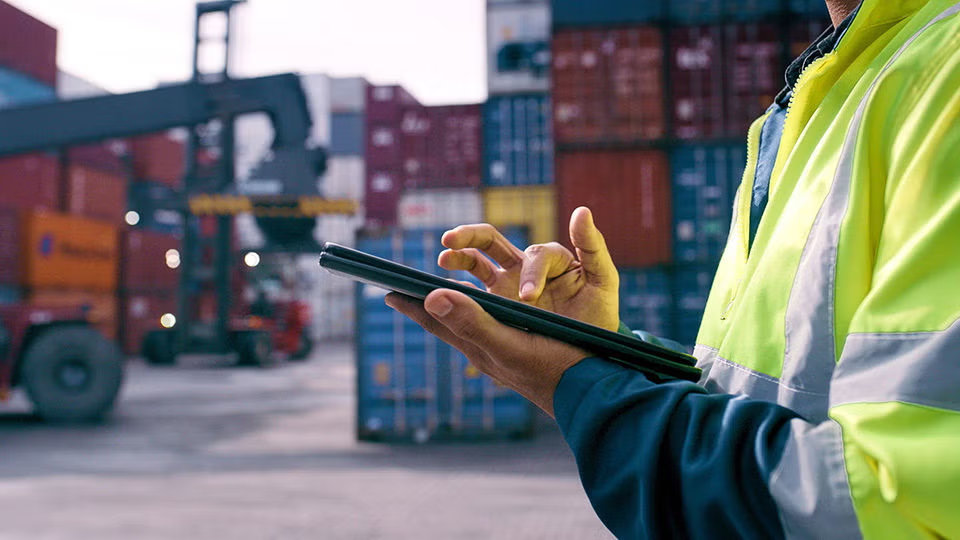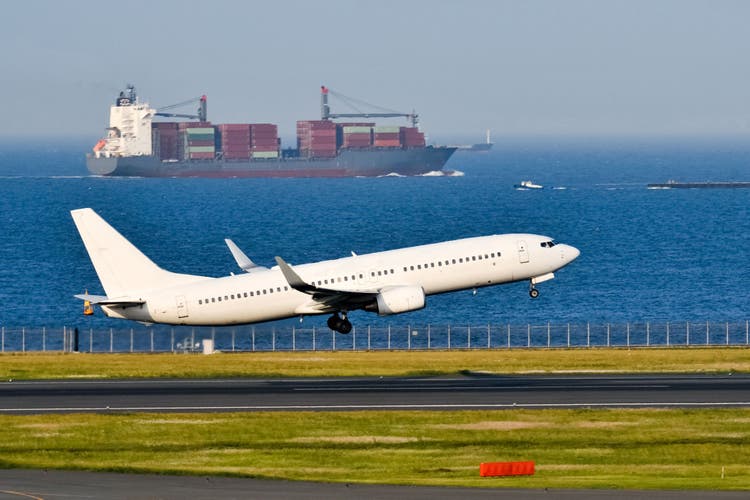Freight and Logistics News and Market Update
Week of October 1, 2025
Top Takeaways
US Tariffs Take Effect, China Tightens Maritime Rules and UPS Expands Intra-Asia Air Freight Network
- As of October 1, the US has implemented new tariffs on key imports, including 100% on certain pharmaceuticals, 50% on kitchen cabinets and bathroom vanities, 30% on upholstered furniture and 25% on heavy trucks. These measures are intended to support domestic manufacturing and address market pressures.
- China has implemented new maritime rules that allow penalties on vessels from countries it views as restricting its shipping sector. This move comes as the US introduces additional fees on Chinese-operated and Chinese-built ships. While some carriers are adjusting fleets to avoid these charges, major Chinese lines plan to continue US service.
- UPS® has expanded its intra-Asia air freight network with more Shenzhen to Sydney flights and upgraded Hanoi to Shenzhen capacity using Boeing 747s. These enhancements support faster deliveries across Asia and Australia and serve key industries such as healthcare, manufacturing and automotive.
Regions
Air
- The US imposed sanctions on Mexico’s aviation sector after the government required freighter operations to move from Mexico City’s Benito Juarez Airport (AICM) to Felipe Angeles Airport (AIFA). The US Department of Transportation said the change and related slot reductions were anti-competitive and caused disruptions, including customs clearance delays and higher costs. The sanctions include ending the Delta Aeromexico joint venture in January 2026 and banning certain charter flights. The US also warned it would take similar action against European governments if American airlines face restrictions there.
- Global air cargo demand grew 4.1% year-over-year in August, marking the sixth consecutive month of expansion. Despite market volatility and ongoing trade uncertainty, demand has remained resilient as some high-value shipments shift from ocean to air freight to avoid potential duties from tariff changes. Growth is also supported by increasing APAC trade flows with Europe and ISMEA, showing a gradual rebalancing of global tradelanes.
Ocean
- China has introduced new maritime rules allowing it to penalize vessels or services from nations it views as targeting its shipping sector. These rules come just as the US prepares to begin imposing extra fees on ships operated by China or built in China, potentially costing major carriers like COSCO billions. Some global carriers are switching to non-Chinese vessels to avoid the upcoming fees, but China’s leading shipping lines say they will continue servicing the US, increasing the risk of further trade friction.
- CMA CGM is reportedly in talks with Cochin Shipyard to build LNG-powered short haul container vessels, potentially making it the first global carrier to place ship orders in India. The plan aligns with India’s multibillion-dollar maritime investment package to strengthen shipbuilding capacity, financing and skills. While Maersk and MSC have also expressed interest in India’s shipbuilding sector, experts caution that infrastructure constraints and higher costs still limit India’s ability to compete with East Asian shipyards.
- US truckload rates are expected to rise modestly in 2026, with contract prices up about 2% and spot rates recovering roughly 6% from recent lows. The market remains tilted toward shippers due to oversupply, weak demand and fierce competition, which prevents carriers from successfully pushing through the 4% to 6% increases they argue are needed to cover inflation and costs. Some carriers are exiting the business and truck orders are declining, yet capacity is still high enough to avert major disruption, suggesting 2026 will see gradual rather than dramatic rate movement.
- Rising tariff costs are motivating US retailers to tighten inventory control and expand faster delivery options like same-day and next-day fulfillment. Retailers like Target are scaling up rapid delivery, while companies like Lowe’s and Academy Sports are deploying advanced planning tools to better match inventory with demand and contain cost. The shift is driving the industry toward integrated logistics systems that unify inventory and transport management, as fragmented systems are struggling under tariff pressure and consumer expectations.
Ocean
- US tariffs of 50% on Brazilian coffee, sugar and orange juice have led to steep drops in import volumes, with double-digit declines in September year-over-year. Spot container rates on the Brazil-US lane have fallen more than 20% as shippers reduce bookings and shift sourcing, often to Mexico. Despite weak demand, carriers plan to add capacity in October, raising the risk of further rate falls on a trade already hampered by low volumes and poor schedule reliability.
- Evergreen plans to expand services into Latin America and the Middle East as growth on traditional US trade lanes weakens. The carrier will deploy larger ships on Asia-to-West Coast South America routes, increase Caribbean and Mediterranean connections and boost links among Asia, India, East Africa and the Red Sea. Supported by a target 29% expansion in fleet capacity by 2029, Evergreen aims to diversify its network even though its revenue fell 13% in the first eight months of 2025.
Air
- UPS® has expanded its intra-Asia air freight network by increasing Shenzhen to Sydney flights and upgrading Hanoi to Shenzhen capacity with Boeing 747s to meet rising regional demand. The enhancements enable faster deliveries across Asia, Australia and support industries including healthcare manufacturing and automotive. This expansion strengthens UPS’s role as a logistics partner in Asia’s resilient and evolving trade environment.
- The Zhengzhou Kuala Lumpur “Air Silk Road” twin hub initiative is set to boost air freight connectivity between China and ASEAN, positioning Malaysia as a central logistics hub. Experts say it could streamline trade expand cargo capacity and support regional economic integration through stronger infrastructure and digitalization.
Ocean
- US container imports from ten major Asian economies reached 1.86 million TEUs in August, up 4.1% year over year but down 2.9% from July, according to Descartes Datamyne data from CBP. Vietnam rose 40.4% and India climbed 33%, while China remained the top source despite a 5.5% drop. South Korea fell 9.8% and Japan declined 7.3%. Total US container imports for August stood at 2.54 million TEUs, up 3.5% compared to last year.
- China has launched a direct break-bulk shipping route between Suzhou and Peru’s Chancay port that cuts transit time by about 5 days. The service, operated by COSCO, is intended to handle irregular oversized industrial cargo including the types used in mining. The new link improves trade efficiency lowers logistical costs and enhances China’s influence across Latin America through strengthened maritime infrastructure.
- Container lines are increasing blank sailings on Asia to North America routes as spot rates continue to fall ahead of Golden Week. Capacity reductions in October are expected to reach nearly 14% on both West Coast and East Coast trans Pacific lanes. Forwarders foresee a weak fourth quarter because frontloading has softened peak season demand, and carriers risk failing to cover fixed costs unless capacity is withdrawn or demand improves before Lunar New Year.
Air
- After the US ended duty free access for low-value Chinese imports in May Europe is seeing a surge in China to Europe ecommerce that is reshaping air freight flows. Overall air cargo volume at European airports has grown about 3% this year but traditional hubs like Frankfurt Paris Heathrow Amsterdam and Leipzig have stagnated or declined. At the same time smaller freighter focused airports are booming. Airports in countries such as Belgium and Hungary and Eastern Europe are positioning themselves as attractive entry points. For example Budapest grew 62%, Prague 41%, Warsaw 19%, Brussels 13% and East Midlands UK 11%.
- A nationwide air transport strike in Italy on September 26, 2025 disrupted operations at major airports especially in Milan Linate, Milan Malpensa, Venice and Cagliari Elmas. Baggage handlers, ground staff and airline crews walked out for several hours causing delays, cancellations and slower cargo processing.
Ocean
- The Drewry World Container Index fell 8% to $1,761 per 40ft container, marking the 15th straight week of declines on major trade routes including Transpacific and Asia to Europe. Asia to Europe spot rates continued to fall with Shanghai-to-Rotterdam down 9% and Shanghai-to-Genoa down 7%. Ocean carriers are reducing capacity ahead of Golden Week, when Chinese factories will close for eight days from October 1. Drewry expects freight rates to keep falling in the coming week.
Ground
- Poland has reopened its key Belarus border crossings including the Terespol-Brest rail route, resuming China-Europe overland trade after nearly two weeks of disruption. The crossings had been closed amid Russian-Belarusian military exercises and security concerns, blocking rail freight and stranding over 1,500 trucks and buses. With the reopening, rail shipments are expected to resume and delays are likely to ease, restoring an overland alternative to sea transport for exporters.
Air
-
SolitAir, the UAE-based B2B airport-to-airport cargo airline, has signed an agreement with World Star Aviation to acquire two Boeing 737-800 freighters. The first was delivered in September 2025, and the second is scheduled for delivery in October. By the end of October, SolitAir’s fleet will include seven 737-800 BCF freighters operating from its 220,000-square-foot logistics facility at Dubai World Central. The airline plans to grow to 20 aircraft by 2027 and to connect more than 50 cities within a six-hour flight radius from Dubai. Its fleet is optimized to handle pharmaceuticals, eCommerce shipments and hazardous materials.
-
Navi Mumbai International Airport will begin operations on September 30, 2025, with an annual cargo capacity of 0.5 million tons, expected to reach full operational capacity by January 2026. Built on 2,865 acres under a public-private partnership, the project is owned 74% by Adani Airports Holdings and 26% by CIDCO. The first phases are estimated to cost Rs 16,700 crore (about USD 2 billion). The airport is designed to ease congestion at CSMIA by creating a twin airport system similar to Dubai or New York. Phase 1 includes one runway and a single terminal for 20 million passengers per year, while the full build-out will provide two runways, four terminals, and capacity for 90 million passengers and 3.2 million tons of cargo annually. Cargo facilities will feature semi-automated handling systems and cold chain infrastructure to support pharmaceuticals, perishables and eCommerce goods.
Ocean
- The Container Corporation of India Ltd. (CONCOR) has launched its first export movement using company owned containers, a milestone for India’s logistics sector and international trade ecosystem. The inaugural shipment left CONCOR’s Inland Container Depot at Whitefield in Bengaluru on September 19, 2025 bound for Jebel Ali, UAE via Chennai Port. The initiative strengthens India’s multimodal logistics framework and aims to improve efficiency in global supply chains. With this step CONCOR is broadening its service portfolio and showing its ability to deliver end to end solutions for exporters, particularly in southern industrial hubs.
- AD Ports Group has launched a global rollout of Low Earth Orbit satellite connectivity across its fleet and 34 terminals after signing agreements with two providers. The phased deployment, starting with several ships, will deliver real time data, strengthen business continuity and support cargo monitoring. By integrating LEO with IoT sensors, smart port platforms and AI analytics, AD Ports aims to cut fuel use through smarter routing and create a fully connected supply chain.
- Starting October 1, the US will implement steep tariffs on several imported goods. Branded and patented pharmaceuticals will face a 100% tariff unless the manufacturer is actively building a production facility in the country. Kitchen cabinets and bathroom vanities will be hit with a 50% tariff, while upholstered furniture will see an additional 30% tariff due to concerns over market saturation. Heavy trucks will incur a 25% tariff to support domestic manufacturers and safeguard the future of US trucking.
- The Department of Commerce has finalized procedures for expanding Section 232 tariffs to more auto parts. Starting October 1, 2025, domestic producers and industry groups can submit inclusion requests during two-week windows held quarterly. Valid requests must include product details, import data and justification for national security concerns. After submission, requests will be posted for public comment, and final decisions will be made within 60 days. Comments on the rule are due by November 3.
- Medical device facilities, both foreign and domestic, must renew their FDA registrations annually to maintain access to the US market. This includes manufacturers, developers, relabelers, importers and exporters. Failure to renew, update or cancel a registration can lead to import restrictions. The current renewal period runs from October 1 to December 31 and is mandatory regardless of when the initial registration occurred.
More Insights From UPS Supply Chain Solutions

Navigating the 2025 Global Tariffs Landscape

2025 Tariffs and Their Impact on Global Trade

Air Freight Shipping Guide: Costs, Documentation & Quotes

Get Started with an Air or Ocean Quote
On our UPS® Forwarding Hub, get and compare quotes, book shipments and track them end-to-end on one modern, easy-to-navigate dashboard.

Stay In The Know
Get expert insights into all things freight and logistics, delivered right to your inbox.